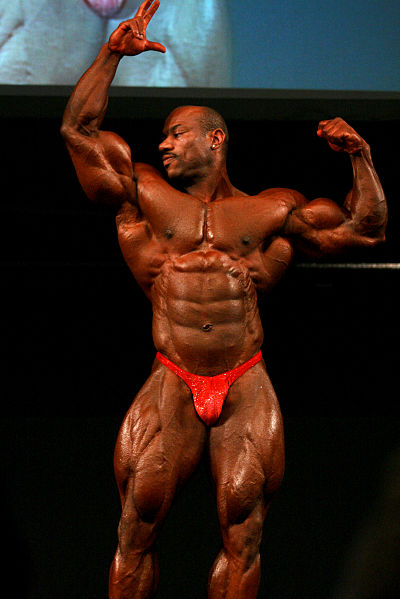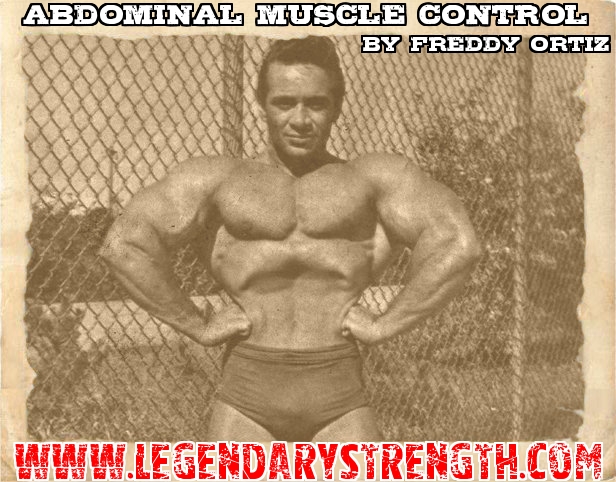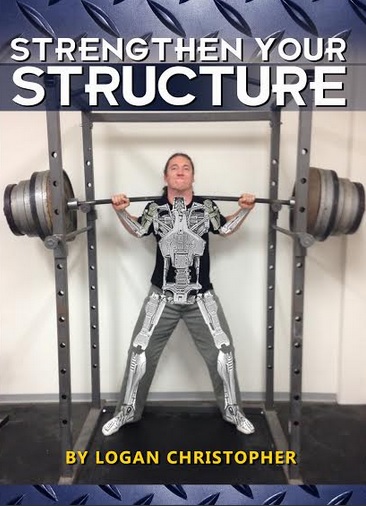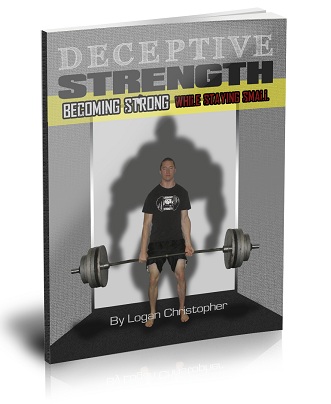The common person out there believes that muscles equal strength and vice versa. But this is not true.
If it were true, then big bodybuilders would dominate every strength sport. They would be the champion powerlifters, strongmen and Olympic lifters. And while there have been a few people that have cross-competed like this in these different things, it is not common practice.
There’s the quote “Looks like Tarzan, plays like Jane,” the term “show muscles” and more that have been used to derogatorily talk about those who are huge but can’t do much. Of course there are some exceptions. Some bodybuilders are very strong, but many are not so.

Are you as strong as you look? Stronger? Weaker?
And if you look at some of those strength legends, many weren’t particularly great to look at, defined or big.
Then there’s also small guys that are very strong. One of my mentors in the strongman space, Dennis Rogers can bend a crescent wrench into a U or an S and never weighs more than 170 lbs. He’s got some muscle but he’s a small guy. You could say the same thing for me. I don’t look like I can do the things I do which is why I came up with the term Deceptive Strength, and wrote a whole book on the subject discussed more here.
Muscle and Strength are Correlated but Not Equal
A bigger muscle is stronger than a smaller muscle, all things else being equal. Of course, this depends on many factors, one of which is the type of training that caused the size.
With Sarcoplasmic Hypertrophy you increase the volume of the muscle cells fluid, the sarcoplasm. You have a bigger muscle but really its not stronger. This is typically done through high rep “pumping” type of work and is what many bodybuilders focus on. Its quick to gain, but also quick to leave.
With Myofibrillar Hypertrophy you’re increasing the size of the muscle fibers themselves. Think of the difference between a string and a cable and you’ll see that here this leads to more strength. A thicker fiber can generally contract harder against a resistance and thus exert more strength. This kind of muscle size is built through more “proper” strength training, which includes heavier weights and lower reps. In any case it must be progressive.
At least that is one theory. Some others say that you can’t really increase the size of the sarcoplasm without an increase in the myofibrils. Instead the increase in size comes about because of more glycogen storage as a result of higher rep training. More glycogen and water storage means a bigger muscle but isn’t necessarily stronger in exerting itself except to do so over and over again.
I guess you get what you train for 🙂
But muscle size, even of the right type, isn’t the only factor in strength either.
What is Strength?
There is no one way to express strength. There are thousands.
Therefore there is no way to clearly state who is the strongest person in the world. The are many that are very strong at what they do, but no one can be the strongest at everything. There’s simply too much out there. And then there are blurred lines if you add strength into more skilled based work. Some things may not take much “strength” at all but are physical abilities in other ways.

Thomas Topham performing a feat of strength – 1386 lbs lift. Just one of many ways to showcase strength.
For many expressions of strength in visually appealing ways check out the Feats of Strength index. A feat of strength is nothing more than a feat that demonstrates your strength, however you choose to do it.
And with these many expressions of strength we can start to look at all the other components involved within it.
As a basic model, strength is the ability to exert force against resistance. This is done through the muscles, although that’s not all as we’ll discuss later. A muscle is made up of many muscle cells. When the command is given these muscle cells either contract or they don’t. Its an all or nothing game so the matter becomes how many of them you can contract.
You’ll never get to 100%. To contract with that much force would snap your bones in half. Apparently, this occurs when some people get struck by lightning. The electric signal makes the muscles contract violently. In the interest of safety, there are limits on what we can do to try to prevent ourselves from causing injury.
Now that we’ve covered the basics of what strength is, let’s talk about several pathways being stronger. There is carryover between the different ones, just some different models of explaining the same things.
Strength Technique
“Strength is a skill.” I first heard this from Pavel Tsatsouline, though its likely been said by others before his time. (Here’s an older article I wrote on this subject.)
And this has to do with several methods to strength we’ll be discussing. The first is technique. Obviously the better your technique, at any given exercise or feat, the stronger you’ll be at it, up to a point.
The basic idea of technique is to use optimal leverage in which to do an exercise. Through the muscles, joints and bones you must move in a certain way in order to accomplish something like putting a weight overhead.
By understanding the principles of leverage and where muscles are stronger and weaker you can use the right “technique” to accomplish something.
But technique also goes beyond this when we begin to discuss skill. We can describe this in two different ways.
Muscle Control and the Nervous System
The “lost art” of muscle control is all about flexing and relaxing the muscles in order to bring them better under your command. The idea being that with better control in isolation and in groups you can then apply this to any outside exercise. And the truth is all exercise can be looked at as muscle control, just different ways of focusing your attention.

If you can control your muscles better this means you can contract them harder. This means more strength. And in a roundabout way, you can relax other muscles which can inhibit the primary or working muscles. This is like putting the foot on the gas pedal and taking it off the brakes, while most people try flooring both of them.
With greater technique, you have greater control, and thus send the commands which contract the muscles to the degree with which you can possibly, and that equals your strength.
Another model to look at this through is the nervous system. The command starts in the brain, travels the nerve pathways to get to the muscles. A stronger command means a stronger contraction. With technique you’ve grooved in the nervous pathway thus making this command work better.
It can be the difference between playing telephone with two cups and a string or having a superconducting wire. This occurs through the body laying down myelin to sheath the nerves. More practice, means more myelin gets added, and thus you are more skilled. Its easier, faster and more automatic than before.
This is apparent in something like a handstand (which really isn’t a strength movement, so much as coordination and balance) or an Olympic snatch (a beautiful combination of strength and skill through explosive force and muscle sequencing). Even if you take a gross motor movement like a deadlift there still is a lot of skill involved.
It’s this reason that beginners get better far faster than elite lifters. There nervous system and how to use their muscles quickly adapts to any new exercise.
Therefore if you improve your technique (by this I mean your skill in the movement or exercise) you’ll be stronger. I’m not talking about things like keep your head up, chest out, but instead of the laying down of myelin to conduct better signals.
Other Structures – Tendons, Ligaments, Bones
So far we’ve talked about muscles and nerves but those aren’t the only thing important for strength. Involved in any exertion of strength are also the tendons and ligaments (sometimes called sinews) as well as the joints and bones.
While you don’t consciously control these the same way as you do as the muscles, they can be very important for strength. In some cases, far more so than the muscles themselves. They’re all tissues like muscles and thus can be built up to become larger. They can’t bulk up quite like muscles can, but they do become thicker and more dense.
To train these specifically you can do certain things like short range partials or supports.
The Mind
No discussion on strength is complete without a discussion of how we think about it. We discussed the nervous system and the brain but the mind is different. (If you think your mind is hiding out in your brain you’ve been misled).
For ease of description the mind can be divided in to the conscious and the subconscious and both effect how strong you are. Things such as beliefs “I’m have weak upper body strength”, “I’m no good at that exercise”, “I have to stretch after workouts or I get sore,” are similar to those nervous system commands that make muscles contract. Except here they direct your body to make things come true.

I’d take someone with a stronger mind, then a stronger body, to be stronger overall and in the long run.
If you don’t believe you’re good at an exercise, how well do you think you’ll be able to get those muscles to contract properly to do it? You’re certainly going to be worse of than if you believed you could do it or even that it was just a possibility.
Like I said, many of these are subconscious. You don’t even know you believe them! But they’re there and influencing everything that you do.
But beliefs don’t just hold you back. They can be empowering and even further expanded on. And beliefs aren’t the only thing.
By working with your mental programming, how you store an exercise internally when you think about it, you can help to send better signals.
It’s working with this fun stuff that I’ve seen people almost magically increase their strength, even doubling it.
At this level you’re working on the frames that govern everything else. To me it makes sense to work on something that can influence everything else.
Building the size of a muscle takes awhile. Shifting your mind can be instant. Stay tuned for my book Mental Muscle all about this subject later this year.
Energy and Qi for Strength
The nervous system works on electricity. Its small amounts, but its there. This dense form of energy is easily measurable. But there are more subtle forms of energy as well. Science is beginning to be able to measure these with much more data to come in the future.
By using something like qi perhaps you just influence everything else we’ve already discussed above. You charge your body up in a certain way like a Shaolin monk ready to do a fingertip handstand. Maybe this just allows your nervous system to better send signals and your muscles to contract and relax as needed…

At this level, you’re certainly accessing strength beyond mere muscles.
Or maybe more is occurring. Maybe the qi more directly works to do the feat. I can’t say for sure, but what I do know is that it can bring about a positive result, however it is working.
There is a whole lot of unexplored territory here…to be covered more in the future.
To Recap
If you came into this article thinking muscles and strength were one and the same thing, I don’t think its possible for you to continue to believe that. We discussed:
- How different types of muscle size can influence its strength
- How other tissues in your body can also influence your strength
- How optimizing your technique to best work with leverage can me the difference between success and failure in a lift
- How skill is about better conducting neural pathways to send the signals to your muscles
- How you can use the model of muscle control to understand how to command your muscles
- How beliefs and mental programming influence everything to do with strength from the top down
- How subtle energy may further enhance your strength
So what are you going to do today to enhance your strength?



Comments
Nice article.
I also think there is a lot of unexplored territory in the way Qi is used for strength and all the different aspects of training of some Asian disciplines.
For some time now that I want to share with you this video of an ancient form of Kung Fu and Qigong of the Dai Family. You can see the masters training in the video and it’s very clear that they use an whole range of different methods and techniques that are really unknown for an occidental mind like ours.
https://youtu.be/m6pHqWe84_c
I think that exploring this new reality and bring it the occidental world can be really groundbreaking. It’s even hard to imagine the potential if this knowledge becomes accessible to western culture…
Paulo
Thanks Paulo.
I’m right with you. I’ve been studying and practicing several energy practices for years now and they’re very impactful. And I think even bigger breakthru’s will come in the future.
Thanks for sharing the video too. I’ll definitely give this a watch.
Hi I have a question two questions one im vary interested in calisthenics and want to get stronger off off them but without getting big and bulk ( kind of like bruise Lee) and I was wondering how rep and set would be done without that many muscle gain while still gaining strength to make progress in body weight training ( I do a lot of cardio but plan on cutting it back a little after next month for strength training. 4-6 miles a day is what Im doing until I lose weight currently 150 pounds my goal is 135-140 lb) . And two my handstand sucks because at least half of my kickups at not successful even when iuse my fingertips to press down but I still topple over or back (I have been training this for more than 6 months and started against a wall) so should I i relearn the handstand or am I forgetting something
Hey Kyle. As I explain in my book sticking with lower rep and low overall volume stuff is a great way to build strength without much muscle, with bodyweight exercises or anything else.
For the handstand, practice the kick-up specifically. These two articles will give you several ideas:
https://breakingmuscle.com/gymnastics/how-to-work-up-to-a-freestanding-handstand
https://breakingmuscle.com/gymnastics/how-to-hold-a-freestanding-handstand
Dude thanks for the progressions for the hand stand but my pickup was bad that’s all ( can hold 10- 15 sec.). And I also just got the assisted one arm pull up.